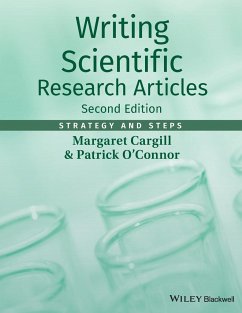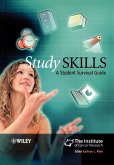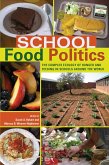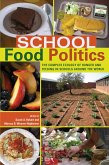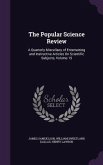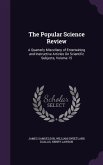27,99 €
inkl. MwSt.
Versandfertig in über 4 Wochen

14 °P sammeln
- Broschiertes Buch
- Merkliste
- Auf die Merkliste
- Bewerten Bewerten
- Teilen
- Produkt teilen
- Produkterinnerung
- Produkterinnerung
This book shows scientists how to apply their analysis and synthesis skills to overcoming the challenge of how to write, as well as what to write, to maximise their chances of publishing in international scientific journals.
The book uses analysis of the scientific article genre to provide clear processes for writing each section of a manuscript, starting with clear 'story' construction and packaging of results. Each learning step uses practical exercises to develop writing and data presentation skills based on reader analysis of well-written example papers. Strategies are presented for…mehr
Andere Kunden interessierten sich auch für
![Study Skills Study Skills]() Study Skills56,99 €
Study Skills56,99 €![Biowissenschaft und Erziehungswissenschaft Biowissenschaft und Erziehungswissenschaft]() Annette Scheunpflug / Christoph Wulf (Hgg.)Biowissenschaft und Erziehungswissenschaft29,99 €
Annette Scheunpflug / Christoph Wulf (Hgg.)Biowissenschaft und Erziehungswissenschaft29,99 €![School Food Politics School Food Politics]() School Food Politics147,80 €
School Food Politics147,80 €![School Food Politics School Food Politics]() School Food Politics39,15 €
School Food Politics39,15 €![The Popular Science Review: A Quarterly Miscellany of Entertaining and Instructive Articles On Scientific Subjects, Volume 15 The Popular Science Review: A Quarterly Miscellany of Entertaining and Instructive Articles On Scientific Subjects, Volume 15]() James SamuelsonThe Popular Science Review: A Quarterly Miscellany of Entertaining and Instructive Articles On Scientific Subjects, Volume 1541,99 €
James SamuelsonThe Popular Science Review: A Quarterly Miscellany of Entertaining and Instructive Articles On Scientific Subjects, Volume 1541,99 €![The Popular Science Review: A Quarterly Miscellany of Entertaining and Instructive Articles On Scientific Subjects, Volume 15 The Popular Science Review: A Quarterly Miscellany of Entertaining and Instructive Articles On Scientific Subjects, Volume 15]() James SamuelsonThe Popular Science Review: A Quarterly Miscellany of Entertaining and Instructive Articles On Scientific Subjects, Volume 1540,99 €
James SamuelsonThe Popular Science Review: A Quarterly Miscellany of Entertaining and Instructive Articles On Scientific Subjects, Volume 1540,99 €![Academic Writing for International Students of Business and Economics Academic Writing for International Students of Business and Economics]() Stephen BaileyAcademic Writing for International Students of Business and Economics26,99 €
Stephen BaileyAcademic Writing for International Students of Business and Economics26,99 €-
-
-
This book shows scientists how to apply their analysis and synthesis skills to overcoming the challenge of how to write, as well as what to write, to maximise their chances of publishing in international scientific journals.
The book uses analysis of the scientific article genre to provide clear processes for writing each section of a manuscript, starting with clear 'story' construction and packaging of results. Each learning step uses practical exercises to develop writing and data presentation skills based on reader analysis of well-written example papers. Strategies are presented for responding to referee comments, and for developing discipline-specific English language skills for manuscript writing and polishing.
The book is designed for scientists who use English as a first or an additional language, and for individual scientists or mentors or a class setting. In response to reader requests, the new edition includes review articles and the full range of research article formats, as well as applying the book's principles to writing funding applications.
Web support for this book is available at www.writeresearch.com.au
Hinweis: Dieser Artikel kann nur an eine deutsche Lieferadresse ausgeliefert werden.
The book uses analysis of the scientific article genre to provide clear processes for writing each section of a manuscript, starting with clear 'story' construction and packaging of results. Each learning step uses practical exercises to develop writing and data presentation skills based on reader analysis of well-written example papers. Strategies are presented for responding to referee comments, and for developing discipline-specific English language skills for manuscript writing and polishing.
The book is designed for scientists who use English as a first or an additional language, and for individual scientists or mentors or a class setting. In response to reader requests, the new edition includes review articles and the full range of research article formats, as well as applying the book's principles to writing funding applications.
Web support for this book is available at www.writeresearch.com.au
Hinweis: Dieser Artikel kann nur an eine deutsche Lieferadresse ausgeliefert werden.
Produktdetails
- Produktdetails
- Verlag: Wiley & Sons / Wiley-Blackwell
- 2nd ed.
- Seitenzahl: 240
- Erscheinungstermin: 10. Mai 2013
- Englisch
- Abmessung: 280mm x 216mm x 13mm
- Gewicht: 690g
- ISBN-13: 9781118570708
- ISBN-10: 1118570707
- Artikelnr.: 37727927
- Herstellerkennzeichnung
- Libri GmbH
- Europaallee 1
- 36244 Bad Hersfeld
- gpsr@libri.de
- Verlag: Wiley & Sons / Wiley-Blackwell
- 2nd ed.
- Seitenzahl: 240
- Erscheinungstermin: 10. Mai 2013
- Englisch
- Abmessung: 280mm x 216mm x 13mm
- Gewicht: 690g
- ISBN-13: 9781118570708
- ISBN-10: 1118570707
- Artikelnr.: 37727927
- Herstellerkennzeichnung
- Libri GmbH
- Europaallee 1
- 36244 Bad Hersfeld
- gpsr@libri.de
Margaret Cargill is an applied linguist with over 20 years experience as a research communication educator. Her current research centres on innovative collaborative methods for helping scientists develop high-level skills for communicating their research findings effectively in the international arena. She has worked extensively in Australia, Europe and Asia with scientists of many language and cultural backgrounds. Patrick O'Connor is a research ecologist, environmental consultant and science educator. His work over the last 15 years has focussed on the use of scientific principles in designing and evaluating environmental programs for governments and statutory authorities in Australia. His research interests and scientific publications span fields of terrestrial ecology and detection of change in plant and animal communities.
Preface to the second edition ix
Preface to the first edition xi
Section 1: A framework for success 1
1 How the book is organized, and why 3
1.1 Getting started with writing for international publication 3
1.2 Publishing in the international literature 4
1.3 What do you need to know to select your target journal? 6
1.4 Aims of this book 7
1.5 How the book is structured 8
2 Research article structures 11
2.1 Conventional article structures: AIMRaD (Abstract, Introduction,
Materials and methods, Results, and Discussion) and its variations 11
3 Reviewers' criteria for evaluating manuscripts 17
3.1 Titles as content signposts 18
Section 2: When and how to write each article section 21
4 Results as a "story": the key driver of an article 23
5 Results: turning data into knowledge 25
5.1 Figure, table, or text? 26
5.2 Designing figures 26
5.3 Designing tables 29
5.4 Figure legends and table titles 31
6 Writing about results 33
6.1 Structure of Results sections 33
6.2 Functions of Results sentences 34
6.3 Verb tense in Results sections 34
7 The Methods section 37
7.1 Purpose of the Methods section 37
7.2 Organizing Methods sections 38
7.3 Use of passive and active verbs 39
8 The Introduction 43
8.1 Argument stages towards a compelling Introduction 43
8.2 Stage 1: Locating your project within an existing field of scientific
research 43
8.3 Using references in Stages 2 and 3 47
8.4 Avoiding plagiarism when using others' work 50
8.5 Indicating the gap or research niche 51
8.6 Stage 4: The statement of purpose or main activity 52
8.7 Stages 5 and 6: Highlighting benefit and mapping the article 52
8.8 Suggested process for drafting an Introduction 53
8.9 Editing for logical flow 54
9 The Discussion section 59
9.1 Important structural issues 59
9.2 Information elements to highlight the key messages 60
9.3 Negotiating the strength of claims 62
10 The title 65
10.1 Strategy 1: Provide as much relevant information as possible, but be
concise 65
10.2 Strategy 2: Use keywords prominently 65
10.3 Strategy 3: Choose strategically: noun phrase, statement, or question?
66
10.4 Strategy 4: Avoid ambiguity in noun phrases 67
11 The Abstract 69
11.1 Why Abstracts are so important 69
11.2 Selecting additional keywords 69
11.3 Abstracts: typical information elements 69
12 Writing review articles 73
12.1 What editors want to publish 75
12.2 The "take-home-message" of a review 75
12.3 The structure of review articles 83
12.4 Visual elements in review articles: tables, figures, and boxes 84
12.5 Checklist for review article manuscripts 86
12.6 Submission and revision of review articles 86
Section 3: Getting your manuscript published 89
13 Submitting a manuscript 91
13.1 Five practices of successful authors 91
13.2 Understanding the peer-review process 92
13.3 Understanding the editor's role 93
13.4 The contributor's covering letter 93
13.5 Understanding the reviewer's role 94
13.6 Understanding the editor's role (continued) 97
14 How to respond to editors and reviewers 99
14.1 Rules of thumb 99
14.2 How to deal with manuscript rejection 99
14.3 How to deal with "conditional acceptance" or "revise and resubmit" 101
15 A process for preparing a manuscript 109
15.1 Initial preparation steps 109
15.2 Editing procedures 110
15.3 A pre-review checklist 113
Section 4: Developing your writing and publication skills further 115
16 Skill-development strategies for groups and individuals 117
16.1 Journal clubs 117
16.2 Writing groups 118
16.3 Selecting feedback strategies for different purposes 118
16.4 Becoming a reviewer 120
16.5 Training for responding to reviewers 121
17 Developing discipline-specific English skills 123
17.1 Introduction 123
17.2 Error types and editor expectations of language use 123
17.3 Strategic (and acceptable!) language re-use: sentence templates 125
17.4 More about noun phrases 128
17.5 Concordancing: a tool for developing your discipline-specific English
129
17.6 Using the English articles (a/an, the) appropriately in science
writing 133
17.7 Using "which" and "that" 136
18 Writing funding proposals 139
18.1 Introduction 139
18.2 A process for preparing and submitting a funding proposal 140
18.3 Easy mistakes to make 143
Section 5: Provided example articles 145
19 PEA1: Kaiser et al. (2003) 147
20 PEA2: Britton-Simmons and Abbott (2008) 159
21 PEA3: Ganci et al. (2012) 171
Answer pages 185
Appendix: Measures of journal impact and quality 213
A.1 Journal impact 213
A.2 Using indices of journal quality 214
References 217
Index 219
Preface to the first edition xi
Section 1: A framework for success 1
1 How the book is organized, and why 3
1.1 Getting started with writing for international publication 3
1.2 Publishing in the international literature 4
1.3 What do you need to know to select your target journal? 6
1.4 Aims of this book 7
1.5 How the book is structured 8
2 Research article structures 11
2.1 Conventional article structures: AIMRaD (Abstract, Introduction,
Materials and methods, Results, and Discussion) and its variations 11
3 Reviewers' criteria for evaluating manuscripts 17
3.1 Titles as content signposts 18
Section 2: When and how to write each article section 21
4 Results as a "story": the key driver of an article 23
5 Results: turning data into knowledge 25
5.1 Figure, table, or text? 26
5.2 Designing figures 26
5.3 Designing tables 29
5.4 Figure legends and table titles 31
6 Writing about results 33
6.1 Structure of Results sections 33
6.2 Functions of Results sentences 34
6.3 Verb tense in Results sections 34
7 The Methods section 37
7.1 Purpose of the Methods section 37
7.2 Organizing Methods sections 38
7.3 Use of passive and active verbs 39
8 The Introduction 43
8.1 Argument stages towards a compelling Introduction 43
8.2 Stage 1: Locating your project within an existing field of scientific
research 43
8.3 Using references in Stages 2 and 3 47
8.4 Avoiding plagiarism when using others' work 50
8.5 Indicating the gap or research niche 51
8.6 Stage 4: The statement of purpose or main activity 52
8.7 Stages 5 and 6: Highlighting benefit and mapping the article 52
8.8 Suggested process for drafting an Introduction 53
8.9 Editing for logical flow 54
9 The Discussion section 59
9.1 Important structural issues 59
9.2 Information elements to highlight the key messages 60
9.3 Negotiating the strength of claims 62
10 The title 65
10.1 Strategy 1: Provide as much relevant information as possible, but be
concise 65
10.2 Strategy 2: Use keywords prominently 65
10.3 Strategy 3: Choose strategically: noun phrase, statement, or question?
66
10.4 Strategy 4: Avoid ambiguity in noun phrases 67
11 The Abstract 69
11.1 Why Abstracts are so important 69
11.2 Selecting additional keywords 69
11.3 Abstracts: typical information elements 69
12 Writing review articles 73
12.1 What editors want to publish 75
12.2 The "take-home-message" of a review 75
12.3 The structure of review articles 83
12.4 Visual elements in review articles: tables, figures, and boxes 84
12.5 Checklist for review article manuscripts 86
12.6 Submission and revision of review articles 86
Section 3: Getting your manuscript published 89
13 Submitting a manuscript 91
13.1 Five practices of successful authors 91
13.2 Understanding the peer-review process 92
13.3 Understanding the editor's role 93
13.4 The contributor's covering letter 93
13.5 Understanding the reviewer's role 94
13.6 Understanding the editor's role (continued) 97
14 How to respond to editors and reviewers 99
14.1 Rules of thumb 99
14.2 How to deal with manuscript rejection 99
14.3 How to deal with "conditional acceptance" or "revise and resubmit" 101
15 A process for preparing a manuscript 109
15.1 Initial preparation steps 109
15.2 Editing procedures 110
15.3 A pre-review checklist 113
Section 4: Developing your writing and publication skills further 115
16 Skill-development strategies for groups and individuals 117
16.1 Journal clubs 117
16.2 Writing groups 118
16.3 Selecting feedback strategies for different purposes 118
16.4 Becoming a reviewer 120
16.5 Training for responding to reviewers 121
17 Developing discipline-specific English skills 123
17.1 Introduction 123
17.2 Error types and editor expectations of language use 123
17.3 Strategic (and acceptable!) language re-use: sentence templates 125
17.4 More about noun phrases 128
17.5 Concordancing: a tool for developing your discipline-specific English
129
17.6 Using the English articles (a/an, the) appropriately in science
writing 133
17.7 Using "which" and "that" 136
18 Writing funding proposals 139
18.1 Introduction 139
18.2 A process for preparing and submitting a funding proposal 140
18.3 Easy mistakes to make 143
Section 5: Provided example articles 145
19 PEA1: Kaiser et al. (2003) 147
20 PEA2: Britton-Simmons and Abbott (2008) 159
21 PEA3: Ganci et al. (2012) 171
Answer pages 185
Appendix: Measures of journal impact and quality 213
A.1 Journal impact 213
A.2 Using indices of journal quality 214
References 217
Index 219
Preface to the second edition ix
Preface to the first edition xi
Section 1: A framework for success 1
1 How the book is organized, and why 3
1.1 Getting started with writing for international publication 3
1.2 Publishing in the international literature 4
1.3 What do you need to know to select your target journal? 6
1.4 Aims of this book 7
1.5 How the book is structured 8
2 Research article structures 11
2.1 Conventional article structures: AIMRaD (Abstract, Introduction,
Materials and methods, Results, and Discussion) and its variations 11
3 Reviewers' criteria for evaluating manuscripts 17
3.1 Titles as content signposts 18
Section 2: When and how to write each article section 21
4 Results as a "story": the key driver of an article 23
5 Results: turning data into knowledge 25
5.1 Figure, table, or text? 26
5.2 Designing figures 26
5.3 Designing tables 29
5.4 Figure legends and table titles 31
6 Writing about results 33
6.1 Structure of Results sections 33
6.2 Functions of Results sentences 34
6.3 Verb tense in Results sections 34
7 The Methods section 37
7.1 Purpose of the Methods section 37
7.2 Organizing Methods sections 38
7.3 Use of passive and active verbs 39
8 The Introduction 43
8.1 Argument stages towards a compelling Introduction 43
8.2 Stage 1: Locating your project within an existing field of scientific
research 43
8.3 Using references in Stages 2 and 3 47
8.4 Avoiding plagiarism when using others' work 50
8.5 Indicating the gap or research niche 51
8.6 Stage 4: The statement of purpose or main activity 52
8.7 Stages 5 and 6: Highlighting benefit and mapping the article 52
8.8 Suggested process for drafting an Introduction 53
8.9 Editing for logical flow 54
9 The Discussion section 59
9.1 Important structural issues 59
9.2 Information elements to highlight the key messages 60
9.3 Negotiating the strength of claims 62
10 The title 65
10.1 Strategy 1: Provide as much relevant information as possible, but be
concise 65
10.2 Strategy 2: Use keywords prominently 65
10.3 Strategy 3: Choose strategically: noun phrase, statement, or question?
66
10.4 Strategy 4: Avoid ambiguity in noun phrases 67
11 The Abstract 69
11.1 Why Abstracts are so important 69
11.2 Selecting additional keywords 69
11.3 Abstracts: typical information elements 69
12 Writing review articles 73
12.1 What editors want to publish 75
12.2 The "take-home-message" of a review 75
12.3 The structure of review articles 83
12.4 Visual elements in review articles: tables, figures, and boxes 84
12.5 Checklist for review article manuscripts 86
12.6 Submission and revision of review articles 86
Section 3: Getting your manuscript published 89
13 Submitting a manuscript 91
13.1 Five practices of successful authors 91
13.2 Understanding the peer-review process 92
13.3 Understanding the editor's role 93
13.4 The contributor's covering letter 93
13.5 Understanding the reviewer's role 94
13.6 Understanding the editor's role (continued) 97
14 How to respond to editors and reviewers 99
14.1 Rules of thumb 99
14.2 How to deal with manuscript rejection 99
14.3 How to deal with "conditional acceptance" or "revise and resubmit" 101
15 A process for preparing a manuscript 109
15.1 Initial preparation steps 109
15.2 Editing procedures 110
15.3 A pre-review checklist 113
Section 4: Developing your writing and publication skills further 115
16 Skill-development strategies for groups and individuals 117
16.1 Journal clubs 117
16.2 Writing groups 118
16.3 Selecting feedback strategies for different purposes 118
16.4 Becoming a reviewer 120
16.5 Training for responding to reviewers 121
17 Developing discipline-specific English skills 123
17.1 Introduction 123
17.2 Error types and editor expectations of language use 123
17.3 Strategic (and acceptable!) language re-use: sentence templates 125
17.4 More about noun phrases 128
17.5 Concordancing: a tool for developing your discipline-specific English
129
17.6 Using the English articles (a/an, the) appropriately in science
writing 133
17.7 Using "which" and "that" 136
18 Writing funding proposals 139
18.1 Introduction 139
18.2 A process for preparing and submitting a funding proposal 140
18.3 Easy mistakes to make 143
Section 5: Provided example articles 145
19 PEA1: Kaiser et al. (2003) 147
20 PEA2: Britton-Simmons and Abbott (2008) 159
21 PEA3: Ganci et al. (2012) 171
Answer pages 185
Appendix: Measures of journal impact and quality 213
A.1 Journal impact 213
A.2 Using indices of journal quality 214
References 217
Index 219
Preface to the first edition xi
Section 1: A framework for success 1
1 How the book is organized, and why 3
1.1 Getting started with writing for international publication 3
1.2 Publishing in the international literature 4
1.3 What do you need to know to select your target journal? 6
1.4 Aims of this book 7
1.5 How the book is structured 8
2 Research article structures 11
2.1 Conventional article structures: AIMRaD (Abstract, Introduction,
Materials and methods, Results, and Discussion) and its variations 11
3 Reviewers' criteria for evaluating manuscripts 17
3.1 Titles as content signposts 18
Section 2: When and how to write each article section 21
4 Results as a "story": the key driver of an article 23
5 Results: turning data into knowledge 25
5.1 Figure, table, or text? 26
5.2 Designing figures 26
5.3 Designing tables 29
5.4 Figure legends and table titles 31
6 Writing about results 33
6.1 Structure of Results sections 33
6.2 Functions of Results sentences 34
6.3 Verb tense in Results sections 34
7 The Methods section 37
7.1 Purpose of the Methods section 37
7.2 Organizing Methods sections 38
7.3 Use of passive and active verbs 39
8 The Introduction 43
8.1 Argument stages towards a compelling Introduction 43
8.2 Stage 1: Locating your project within an existing field of scientific
research 43
8.3 Using references in Stages 2 and 3 47
8.4 Avoiding plagiarism when using others' work 50
8.5 Indicating the gap or research niche 51
8.6 Stage 4: The statement of purpose or main activity 52
8.7 Stages 5 and 6: Highlighting benefit and mapping the article 52
8.8 Suggested process for drafting an Introduction 53
8.9 Editing for logical flow 54
9 The Discussion section 59
9.1 Important structural issues 59
9.2 Information elements to highlight the key messages 60
9.3 Negotiating the strength of claims 62
10 The title 65
10.1 Strategy 1: Provide as much relevant information as possible, but be
concise 65
10.2 Strategy 2: Use keywords prominently 65
10.3 Strategy 3: Choose strategically: noun phrase, statement, or question?
66
10.4 Strategy 4: Avoid ambiguity in noun phrases 67
11 The Abstract 69
11.1 Why Abstracts are so important 69
11.2 Selecting additional keywords 69
11.3 Abstracts: typical information elements 69
12 Writing review articles 73
12.1 What editors want to publish 75
12.2 The "take-home-message" of a review 75
12.3 The structure of review articles 83
12.4 Visual elements in review articles: tables, figures, and boxes 84
12.5 Checklist for review article manuscripts 86
12.6 Submission and revision of review articles 86
Section 3: Getting your manuscript published 89
13 Submitting a manuscript 91
13.1 Five practices of successful authors 91
13.2 Understanding the peer-review process 92
13.3 Understanding the editor's role 93
13.4 The contributor's covering letter 93
13.5 Understanding the reviewer's role 94
13.6 Understanding the editor's role (continued) 97
14 How to respond to editors and reviewers 99
14.1 Rules of thumb 99
14.2 How to deal with manuscript rejection 99
14.3 How to deal with "conditional acceptance" or "revise and resubmit" 101
15 A process for preparing a manuscript 109
15.1 Initial preparation steps 109
15.2 Editing procedures 110
15.3 A pre-review checklist 113
Section 4: Developing your writing and publication skills further 115
16 Skill-development strategies for groups and individuals 117
16.1 Journal clubs 117
16.2 Writing groups 118
16.3 Selecting feedback strategies for different purposes 118
16.4 Becoming a reviewer 120
16.5 Training for responding to reviewers 121
17 Developing discipline-specific English skills 123
17.1 Introduction 123
17.2 Error types and editor expectations of language use 123
17.3 Strategic (and acceptable!) language re-use: sentence templates 125
17.4 More about noun phrases 128
17.5 Concordancing: a tool for developing your discipline-specific English
129
17.6 Using the English articles (a/an, the) appropriately in science
writing 133
17.7 Using "which" and "that" 136
18 Writing funding proposals 139
18.1 Introduction 139
18.2 A process for preparing and submitting a funding proposal 140
18.3 Easy mistakes to make 143
Section 5: Provided example articles 145
19 PEA1: Kaiser et al. (2003) 147
20 PEA2: Britton-Simmons and Abbott (2008) 159
21 PEA3: Ganci et al. (2012) 171
Answer pages 185
Appendix: Measures of journal impact and quality 213
A.1 Journal impact 213
A.2 Using indices of journal quality 214
References 217
Index 219
